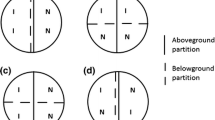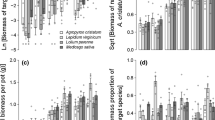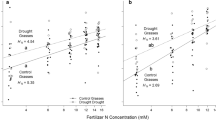Abstract
Differences in resource acquisition between native and exotic plants is one hypothesis to explain invasive plant success. Mechanisms include greater resource acquisition rates and greater plasticity in resource acquisition by invasive exotic species compared to non-invasive natives. We assess the support for these mechanisms by comparing nitrate acquisition and growth of invasive annual and perennial grass seedlings in western North America. Two invasive exotic grasses (Bromus tectorum and Taeniatherum caput-medusae) and three perennial native and exotic grasses (Pseudoroegneria spicata, Elymus elymoides, and Agropyron cristatum) were grown at various temperatures typical of autumn and springtime when resource are abundant and dominance is determined by rapid growth and acquisition of resources. Bromus tectorum and perennial grasses had similar rates of nitrate acquisition at low temperature, but acquisition by B. tectorum significantly exceeded perennial grasses at higher temperature. Consequently, B. tectorum had the highest acquisition plasticity, showcasing its ability to take advantage of transient warm periods in autumn and spring. Nitrate acquisition by perennial grasses was limited either by root production or rate of acquisition per unit root mass, suggesting a trade-off between nutrient acquisition and allocation of growth to structural tissues. Our results indicate the importance of plasticity in resource acquisition when temperatures are warm such as following autumn emergence by B. tectorum. Highly flexible and opportunistic nitrate acquisition appears to be a mechanism whereby invasive annual grasses exploit soil nitrogen that perennials cannot use.



Similar content being viewed by others
References
Arredondo JT, Jones TA, Johnson DA (1998) Seedling growth of intermountain perennial and weedy annual grasses. J Range Manage 51:584–589
Baker HG (1974) The evolution of weeds. Ann Rev Ecol Syst 5:1–24
BassiriRad H, Caldwell MM, Bilbrough C (1993) Effects of soil temperature and nitrogen status on kinetics of 15NO3 − uptake by roots of field-grown Agropyron desertorum. New Phytol 123:485–489
Booth MS, Stark JM, Caldwell MM (2003) Inorganic N turnover and availability in annual- and perennial-dominated soils in a northern Utah shrub-steppe ecosystem. Biogeochemistry 66:311–330
Brooks ML, D’Antonio CM, Richardson DM, Grace JB, Keeley JE, DiTomaso JM, Hobbs RJ, Pellant M, Pyke D (2004) Effects of invasive alien plants on fire regimes. Bioscience 54:677–688
Cavaleri MA, Sack L (2010) Comparative water use of native and invasive plants at multiple scales: a global meta-analysis. Ecology 91:2705–2715
Chambers JC, Roundy BA, Blank RR, Meyer SE, Whittaker A (2007) What makes Great Basin sagebrush ecosystems invasible by Bromus tectorum? Ecol Monogr 77:117–145
Chapin FS III, Van Cleve K, Tryon PR (1986) Relationship of ion absorption to growth rate in taiga trees. Oecologia 69:238–242
Clausnitzer DW, Borman MM, Johnson DE (1999) Competition between Elymus elymoides and Taeniatherum caput-medusae. Weed Sci 47:720–728
Cui M, Caldwell MM (1997) A large ephemeral release of nitrogen upon wetting of dry soil and corresponding root responses in the field. Plant Soil 191:291–299
Daehler CC (2003) Performance comparisons of co-occurring native and alien invasive plants: implications for conservation and restoration. Ann Rev Ecol Evol Syst 34:183–211
Davies KW (2010) Revegetation of medusahead-invaded sagebrush steppe. Range Ecol Manage 63:564–571
Davis MA, Pelsor M (2001) Experimental support for a resource-based mechanistic model of invasibility. Ecol Lett 4:421–428
Davis MA, Grime JP, Thompson K (2000) Fluctuating resources in plant communities: a general theory of invasibility. J Ecol 88:528–534
Dawson W, Fischer M, van Kleunen M (2010) The maximum relative growth rate of common UK plant species is positively associated with their global invasiveness. Global Ecol Biogeogr 20:299–306
Díaz S, Hodgson JG, Thompson K, Cabido M, Cornelissen JHC, Jalili A, Montserrat-Martí G, Grime JP, Zarrinkamar F, Asri Y, Band SR, Basconcelo S, Castro-Díez P, Funes G, Hamzehee B, Khoshnevi M, Pérez-Harguindeguy N, Pérez-Rontomé MC, Shirvany FA, Vendramini F, Yazdani S, Abbas-Azimi R, Bogaard A, Boustani S, Charles M, Dehghan M, Torres-Espuny L, Falczuk V, Guerrero-Campo J, Hynd A, Jones G, Kowsary E, Kazemi-Saeed F, Maestro-Martínez M, Romo-Díez A, Shaw S, Siavash B, Villar-Salvador P, Zak MR (2004) The plant traits that drive ecosystems: evidence from three continents. J Veg Sci 15:295–304
Droste T, Flory SL, Clay K (2010) Variation for phenotypic plasticity among populations of an invasive exotic grass. Plant Ecol 207:297–306
Feng Y, Wang J, Sang W (2007) Biomass allocation, morphology and photosynthesis of invasive and noninvasive exotic species grown at four irradiance levels. Acta Oecol 31:40–47
Funk JL, Vitousek PM (2007) Resource-use efficiency and plant invasion in low-resource systems. Nature 446:1079–1081
Gessler A, Schneider S, Von Sengbusch D, Weber P, Hanemann U, Huber C, Rothe A, Kreutzer K, Rennenberg H (1998) Field and laboratory experiments on net uptake of nitrate and ammonium by the roots of spruce (Picea abies) and beech (Fagus sylvatica) trees. New Phytol 138:275–285
Glass ADM, Britto DT, Kaiser BN, Kinghorn JR, Kronzucker J, Kumar A, Okamoto M, Rawat S, Siddiqi MY, Unkles E, Vidmar JJ (2002) The regulation of nitrate and ammonium transport systems in plants. J Exp Bot 53:855–864
Grime JP (1974) Vegetation classification by reference to strategies. Nature 250:26–31
Grotkopp E, Rejmánek M, Rost TL (2002) Toward a causal explanation of plant invasiveness: seedling growth and life-history strategies of 29 pine (Pinus) species. Am Nat 159:396–419
Heger T, Trepl L (2003) Predicting biological invasions. Biol Invasions 5:313–321
Hierro JL, Villarreal D, Eren O, Graham JM, Callaway RM (2006) Disturbance facilitates invasion: the effects are stronger abroad than at home. Am Nat 168:144–156
Hironaka M, Sindelar BW (1973) Reproductive success of squirreltail in medusahead infested ranges. J Range Manage 26:219–221
Hironaka M, Tisdale EW (1963) Secondary succession in annual vegetation in Southern Idaho. Ecology 44:810–812
Hooker TD, Stark JM, Leffler AJ, Peek M, Ryel R (2008) Distribution of ecosystem C and N within contrasting vegetation types in a semiarid rangeland in the Great Basin, USA. Biogeochemistry 90:291–308
Humphrey LD, Schupp EW (2004) Competition as a barrier to establishment of a native perennial grass (Elymus elymoides) in alien annual grass (Bromus tectorum) communities. J Arid Environ 58:405–422
Ivans CY, Leffler AJ, Spaulding U, Stark JM, Ryel RJ, Caldwell MM (2003) Root responses and nitrogen acquisition by Artemisia tridentata and Agropyron desertorum following small summer rainfall events. Oecologia 134:317–324
James JJ (2008a) Effect of soil nitrogen stress on the relative growth rate of annual and perennial grasses in the Intermountain West. Plant Soil 310:201–210
James JJ (2008b) Leaf nitrogen productivity as a mechanism driving the success of invasive annual grasses under low and high nitrogen supply. J Arid Environ 72:1775–1784
James JJ, Drenovsky RE, Monaco TA, Rinella M (2011) Managing soil nitrogen to restore annual grass infested plant communities: an effective strategy or incomplete framework? Ecol Appl 21:490–502
Knapp PA (1996) Cheatgrass (Bromus tectorum L) dominance in the Great Basin Desert. Global Environ Chang 6:37–52
Leffler AJ, Peek MS, Ryel RJ, Ivans CY, Caldwell MM (2005) Hydraulic redistribution through the root systems of senesced plants. Ecology 86:633–642
Lonsdale WM (1999) Global patterns of plant invasions and the concept of invasibility. Ecology 80:1522–1536
Meyer SE, Allen PS (1999) Ecological genetics of seed germination regulation in Bromus tectorum L. I. Phenotypic variance among and within populations. Oecologia 120:27–34
Monaco TA, Johnson DA, Norton JM, Jones TA, Connors KJ, Norton JB, Redinbaugh MB (2003a) Contrasting responses of Intermountain West grasses to soil nitrogen. J Range Manage 56:282–290
Monaco TA, Mackown CT, Johnson DA, Jones TA, Norton JM, Norton JB, Redinbaugh MB (2003b) Nitrogen effects on seed germination and seedling growth. J Range Manage 56:646–653
Nye PH, Tinker PB (1977) Solute movement in the soil-root system. Blackwell, Oxford
Pyšek P, Richardson DM (2007) Traits associated with invasive alien plants: where do we stand. In: Nentwig W (ed) Biological invasions, Vol. 193. Ecological studies. Springer-Verlag, Berlin, pp 97–125
Quinn GP, Keough MJ (2002) Experimental design and data analysis for biologists. Cambridge University Press, Cambridge, UK
Ramakrishnan AP, Meyer SE, Fairbanks DJ, Coleman CE (2006) Ecological significance of microsatellite variation in western North American populations of Bromus tectorum. Plant Spec Biol 21:61–73
Rice KJ, Mack RN (1991) Ecological genetics of Bromus tectorum II. Intraspecific variation in phenotypic plasticity. Oecologia 88:84–90
Richards CL, Bossdorf O, Muth NZ, Gurevitch J, Pigliucci M (2006) Jack of all trades, master of some? On the role of phenotypic plasticity in plant invasions. Ecol Lett 9:981–993
Rodgers CO, Barneix AJ (1988) Cultivar differences in the rate of nitrate uptake by intact wheat plants as related to growth rate. Physiol Plant 72:121–126
Ryel RJ, Leffler AJ, Ivans C, Peek MS, Caldwell MM (2010) Functional differences in water-use patterns of contrasting life forms in Great Basin steppelands. Vadose Zone J 9:548–560
Seabloom EW, Harpole WS, Reichman OJ, Tilman D (2003) Invasion, competitive dominance, and resource use by exotic and native California grassland species. Proc Natl Acad Sci USA 100:13384–13389
Simberloff D, Von Holle B (1999) Positive interactions of nonindigenous species: invasional meltdown? Biol Invasions 1:21–32
Tian QY, Chen FJ, Zhang FS, Mi GH (2006) Genotypic difference in nitrogen acquisition ability in maize plants is related to the coordination of leaf and root growth. J Plant Nutr 29:317–330
Tilman D (2004) Niche tradeoffs, neutrality, and community structure: a stochastic theory of resource competition, invasion, and community assembly. Proc Natl Acad Sci USA 101:10854–10861
Valladares F, Wright SJ, Lasso E, Kitajima K, Pearcy RW (2000) Plastic phenotypic response to light of 16 congeneric shrubs from a Panamanian rainforest. Ecology 81:1925–1936
Warren CR (2009) Why does temperature affect relative uptake rates of nitrate, ammonium and glycine: a test with Eucalyptus pauciflora. Soil Biol Biochem 41:778–784
Wedin D, Tilman D (1993) Competition among grasses along a nitrogen gradient: initial conditions and mechanisms of competition. Ecol Monog 63:199–229
West NE, Young JA (2000) Intermountain valleys and lower mountain slopes. In: Barbour MG, Billings WD (eds) North American terrestrial vegetation, 2nd edn. Cambridge University Press, Cambridge, UK, pp 256–284
Westoby M, Falster DS, Moles AT, Vesk PA, Wright IJ (2002) Plant ecological strategies: some leading dimensions of variation between species. Ann Rev Ecol Syst 33:125–159
Wright IJ, Reich PB, Westoby M, Ackerly DD, Baruch Z, Bongers F, Cavender-Bares J, Chapin T, Cornelissen JHC, Diemer M, Flexas J, Garnier E, Groom PK, Gulias J, Hikosaka K, Lamont BB, Lee T, Lee W, Lusk C, Midgley JJ, Navas M-L, Niinemets U, Oleksyn J, Osada N, Poorter H, Poot P, Prior L, Pyankov VI, Roumet C, Thomas SC, Tjoelker MG, Veneklaas EJ, Villar R (2004) The worldwide leaf economics spectrum. Nature 428:821–827
Young JA (1992) Ecology and management of medusahead (Taeniatherum caput-medusae ssp. Asperum [Simk.] Melderis). Great Basin Nat 52:245–252
Zou J, Rogers WE, Siemann E (2007) Differences in morphological and physiological traits between native and invasive populations of Sapium sebiferum. Funct Ecol 21:721–730
Acknowledgments
This work is a contribution from the USDA Area Wide EBIPM project. A. J. Leffler was responsible for design, data collection, analysis, and writing. T. A. Monaco and J. J. James contributed to design, analysis, and writing. Special thanks to J. Williams, S. Felix, and R. Watson for laboratory assistance.
Author information
Authors and Affiliations
Corresponding author
Rights and permissions
About this article
Cite this article
Leffler, A.J., Monaco, T.A. & James, J.J. Nitrogen acquisition by annual and perennial grass seedlings: testing the roles of performance and plasticity to explain plant invasion. Plant Ecol 212, 1601–1611 (2011). https://doi.org/10.1007/s11258-011-9933-z
Received:
Accepted:
Published:
Issue Date:
DOI: https://doi.org/10.1007/s11258-011-9933-z




